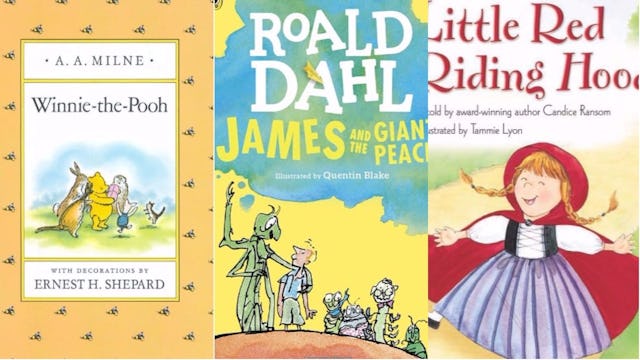Only Children's Books With Humans Actually Teach Our Kids Moral Lessons

Study finds real characters allow kids to apply what they learn in books better than fantasy ones
The pages of children’s books have long been filled with illustrations of farmer bunnies and ornery ducks. These books allow our kids a chance to immerse themselves in a fantasy world of talking animals that go on adventures and drive cars. Children’s books are also used to teach our kids life lessons – whether it’s sharing, sticking up for our friends, or helping others – especially in their early years.
But according to a new study, books that feature anthropomorphized animals (meaning attributing human traits, emotions, and intentions to animal-like characters) aren’t as effective in teaching our children as books that feature actual animals or humans.
A review of 1000 children’s books back in 2002 found while over half of children’s books featured animals in them, less than two percent portrayed those animals realistically. Instead, most authors and illustrators used anthropomorphized animals, assuming since kids like animals, they’d really like cartoon-like ones and would learn similar life lessons regardless of the characters. The only problem is, no one actually tested this theory or ever asked kids what they prefer, and it turns out kids learn better from books with actual animals and humans instead.
Image via Amazon
Previous researchers found kids may actually learn more about how to socialize, share and how to solve problems from stories depicting real animals and real people over fantastical ones. So basically, even though the sloths in Zootopia are hilariously trying to teach our kids patience, putting actual (and equally adorable we may add) sloths with regular people in a DMV would have actually taught young children a lesson in patience that they could apply to their own lives.
Image via Amazon
This most recent study published in the Journal of Developmental Science set out to find out once and for all if children “consider physical and social problems encountered in the fantasy world to be different from those in the real world” and have difficulty transferring this knowledge or if kids are able to apply the rules universally can “transcend all worlds, fantastic and real.”
They read the 96 kids who participated (aged four to six) a book about sharing, some with human characters, others a book about sharing with anthropomorphic animal characters and the third group a control book about seeds.
What they found through the sharing of stickers after the books were read were “reading the human story significantly increased preschoolers’ altruistic giving but reading the anthropomorphic story or the control story decreased it.” The study also found children who were given the book with human characters acted more generous, while “in contrast, there was no difference in generosity between children who read the book with anthropomorphised animal characters and the control book; both groups showed a decrease in sharing behaviour.”
Image via Amazon
One reason may be that children, before the age of five, have a hard time distinguishing fantasy from reality. The study also found children were unable to learn from the anthropomorphic book because they treated anthropomorphic characters more as animals than as humans and may not identify with these characters as being similar to themselves, making it harder to apply the lesson of the story to their own lives.
This is not to say fantasy stories with sleepy bears or mice that drive cars aren’t good for young kids – all kids enjoy these kinds of books and they provide an early love of literature – but they aren’t “effective for teaching real world knowledge or real life social behaviors as realistic ones.”
Sometimes treating kids like intelligent human beings who understand more than we give them credit for actually helps kids learn. Good to know.
This article was originally published on